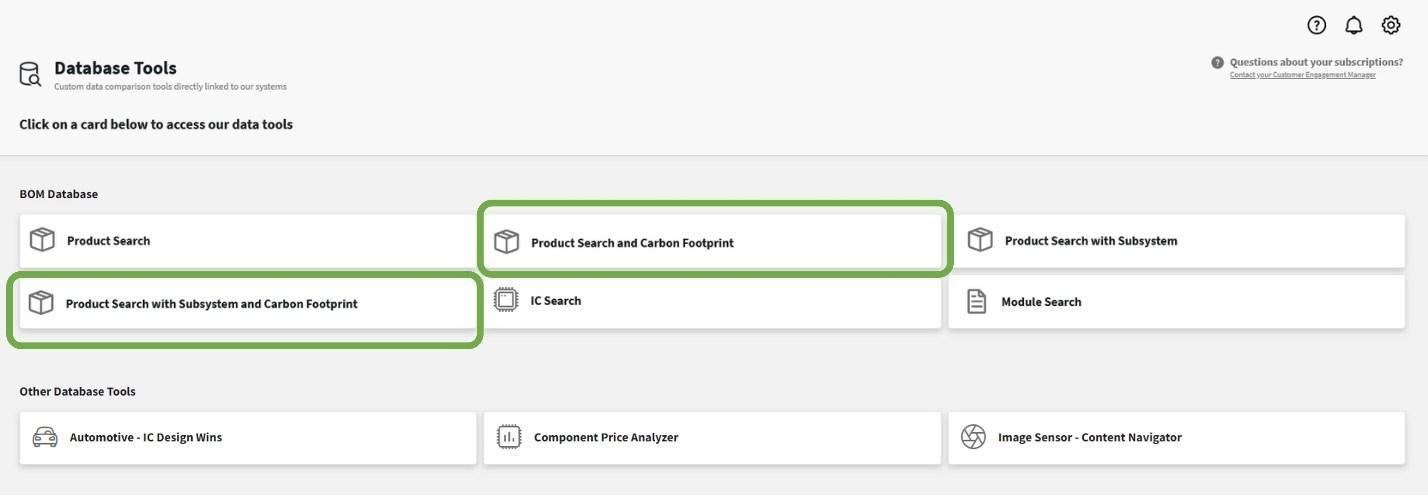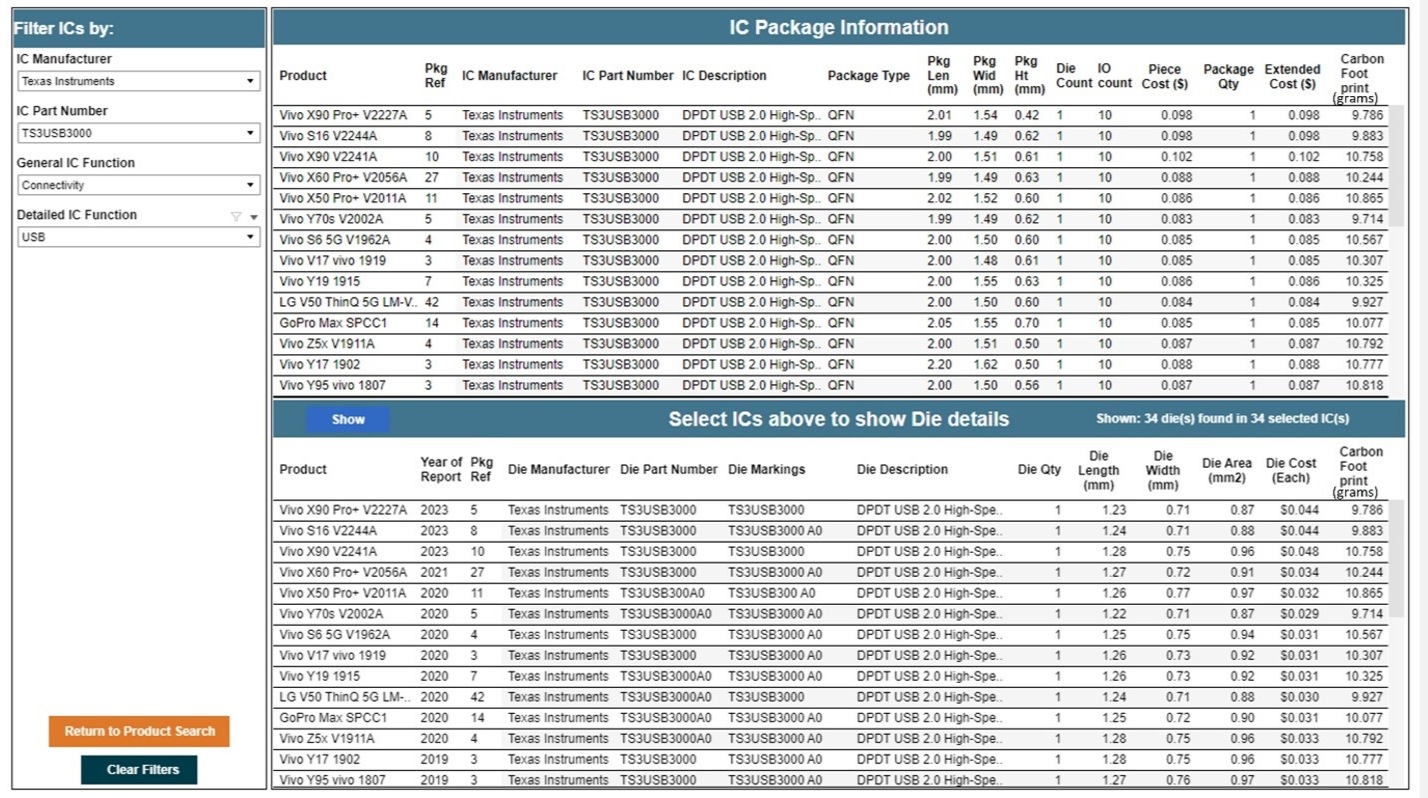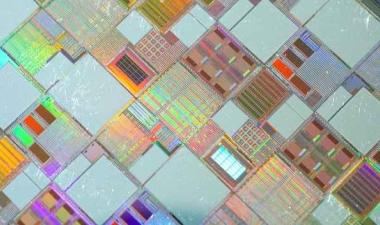TechInsights Launches the BOM Data Carbon Emissions Modules
Helping Inform Subscribers to Help Achieve Their Sustainability Goals

With the 28th annual United Nations Conference of the Parties (COP28) continues in Dubai this week, the topic of climate impact and sustainability is at the top of the news cycle. As TechInsights is the authoritative information source of the semiconductor industry, sustainability is one of our key topics of focus. We continue to develop fact-based data to inform our customers on their sustainability journey. Our latest set of sustainability products—the BOM Database Carbon Emissions Modules (Figure 1)—were just released
Just as TechInsights provides unbiased analysis and cost data in our long-standing industry-leading BOM Database products, the TechInsights team is expanding our portfolio to include sustainability-focused products. The BOM Database Carbon Emissions Modules provide subscribers with a carbon footprint baseline to compare and apply to all integrated circuit (IC) dies in the BOM Database from 2012 onwards. Our algorithm uses several factors including a 0% carbon abatement factor and the report date when the IC was identified. These factors provide subscribers with historical IC die carbon emission calculations as well as the carbon impact of the latest IC dies found on the market today (Figure 2).
Every Detail Counts
Current BOM Database and Teardown subscribers know we measure every IC die, big and small, in every device we analyze. Subscribers with access to the new BOM Database Carbon Emissions Modules will see how the die area and manufacturing date can impact the carbon emissions of a specific IC die (Figure 3).
The Unseen Weight of Electronic Devices
Why is TechInsights so focused on carbon emissions and why have we doubled down to gather this data on the smallest IC die? It’s because IC components are everywhere, from our electric toothbrushes to our cars, and their combined carbon impact might be surprising.
Carbon emissions are measured in grams as the smallest of units. Still, because of the large amounts released into the atmosphere, it is more often measured in kilograms, metric tons, megatons, and gigatons.
Most of an electronic device's carbon impact occurs during the manufacturing of the device as well as its components and parts. To effectively reduce the carbon emissions released into the atmosphere during the manufacturing of the device and its parts, extensive and detailed analysis and data collection are required for every process and at every step of the manufacture for each part and component of a device's life cycle. A subscription to either of the BOM Database Carbon Emissions Modules allows subscribers to begin their carbon analysis at the IC die level.
Table 1 shows the IC Die CO2e weight calculated for three popular mobile devices, and it identifies the component in each device with the highest calculated CO2e.
Phone Model
Total BOM IC Die CO2e Impact
Number of IC Die in Phone
IC Die with Highest CO2e Impact
IC Die CO2e Impact
Apple iPhone 14
21.708 kg
160
Apple A15 Bionic
5.520 kg
Apple iPhone 15 Pro
25.700 kg
110
Apple A17 Pro
6.721 kg
Samsung Galaxy S23
24.713 kg
133
Qualcomm Snapdragon 8 Gen 2
7.452 kg
Table 1. IC die CO2e weight. BOM Database Carbon Emissions Modules. TechInsights (2023).
These numbers may be alarming for a few reasons. First, the carbon emissions calculations are only for the phones' IC dies, representing only part of what a full life cycle assessment needs to quantify a phone's total carbon impact.
Second, the carbon calculations are for one unit. Multiplying the IC die carbon numbers in Table 1 by the total number of the shipments for each phone, the IC die CO2e quantities are best described in metric tons instead of kilograms. For example, in the TechInsights Smartphone Country Share Tracker, Apple shipped 3.8 million units of the base iPhone 14 in Q3 2022. At 21.708 kg of CO2e per unit from its IC die, the total IC Die CO2e is estimated to be over 82,490 metric tons for the quarter from the IC dies alone. A year later, Apple shipped 4.4 million Apple iPhone 15 Pro models in Q3 2023, which calculates to over 113,000 metric tons of carbon emissions from its IC dies.
Take note, however, that CO2e calculations in the BOM Database Carbon Emissions Modules assume 0% abatement for all semiconductor fabs. We expect there are some abatement efforts that vary from fab to fab to reduce their carbon impact. To partner with this analysis is the Semiconductor Manufacturing Carbon Model which allows subscribers to adjust for abatement measure by vendor, by location, by facility, and by process.
The BOM Database Carbon Emissions Modules provide critical IC die carbon emission calculations for subscribers—from semiconductor fabs, fabless IC manufacturers, device OEMs, life cycle analysts, and their customers—to quickly compare, analyze, and make fact-based decisions to support their sustainability goals.

















